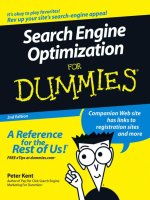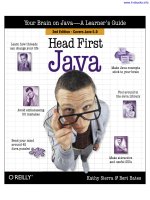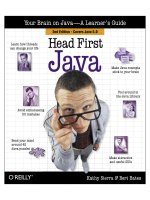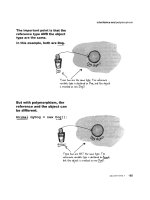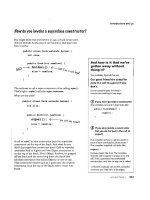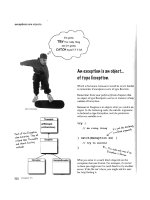head first csharp 2nd edition may 2010
Bạn đang xem bản rút gọn của tài liệu. Xem và tải ngay bản đầy đủ của tài liệu tại đây (29.88 MB, 840 trang )
Advance Praise for Head First C#
“I’ve never read a computer book cover to cover, but this one held my interest from the first page to the
last. If you want to learn C# in depth and have fun doing it, this is THE book for you.”
— Andy Parker, fledgling C# programmer
“It’s hard to really learn a programming language without good engaging examples, and this book is full
of them! Head First C# will guide beginners of all sorts to a long and productive relationship with C#
and the .NET Framework.”
—Chris Burrows, developer for Microsoft’s C# Compiler team
“With Head First C#, Andrew and Jenny have presented an excellent tutorial on learning C#. It is very
approachable while covering a great amount of detail in a unique style. If you’ve been turned off by
more conventional books on C#, you’ll love this one.”
—Jay Hilyard, software developer, co-author of C# 3.0 Cookbook
“I’d reccomend this book to anyone looking for a great introduction into the world of programming and
C#. From the first page onwards, the authors walks the reader through some of the more challenging
concepts of C# in a simple, easy-to-follow way. At the end of some of the larger projects/labs, the
reader can look back at their programs and stand in awe of what they’ve accomplished.”
—David Sterling, developer for Microsoft’s Visual C# Compiler team
“Head First C# is a highly enjoyable tutorial, full of memorable examples and entertaining exercises. Its
lively style is sure to captivate readers—from the humorously annotated examples, to the Fireside Chats,
where the abstract class and interface butt heads in a heated argument! For anyone new to programming,
there’s no better way to dive in.”
— Joseph Albahari, C# Design Architect at Egton Medical Information Systems,
the UK’s largest primary healthcare software supplier,
co-author of C# 3.0 in a Nutshell
“[Head First C#] was an easy book to read and understand. I will recommend this book to any developer
wanting to jump into the C# waters. I will recommend it to the advanced developer that wants to
understand better what is happening with their code. [I will recommend it to developers who] want to
find a better way to explain how C# works to their less-seasoned developer friends.”
—Giuseppe Turitto, C# and ASP.NET developer for Cornwall Consulting Group
“Andrew and Jenny have crafted another stimulating Head First learning experience. Grab a pencil, a
computer, and enjoy the ride as you engage your left brain, right brain, and funny bone.”
—Bill Mietelski, software engineer
“Going through this Head First C# book was a great experience. I have not come across a book series
which actually teaches you so well.…This is a book I would definitely recommend to people wanting to
learn C#”
—Krishna Pala, MCP
Praise for other Head First books
“Kathy and Bert’s Head First Java transforms the printed page into the closest thing to a GUI you’ve ever
seen. In a wry, hip manner, the authors make learning Java an engaging ‘what’re they gonna do next?’
experience.”
—Warren Keuffel, Software Development Magazine
“Beyond the engaging style that drags you forward from know-nothing into exalted Java warrior status,
Head First Java covers a huge amount of practical matters that other texts leave as the dreaded “exercise
for the reader….” It’s clever, wry, hip and practical—there aren’t a lot of textbooks that can make that
claim and live up to it while also teaching you about object serialization and network launch protocols. ”
— Dr. Dan Russell, Director of User Sciences and Experience Research
IBM Almaden Research Center (and teaches Artificial Intelligence at
Stanford University)
“It’s fast, irreverent, fun, and engaging. Be careful—you might actually learn something!”
— Ken Arnold, former Senior Engineer at Sun Microsystems
Co-author (with James Gosling, creator of Java),
The Java Programming Language
“I feel like a thousand pounds of books have just been lifted off of my head.”
—Ward Cunningham, inventor of the Wiki and founder of the Hillside Group
“Just the right tone for the geeked-out, casual-cool guru coder in all of us. The right reference for
practical development strategies—gets my brain going without having to slog through a bunch of tired
stale professor -speak.”
— Travis Kalanick, Founder of Scour and Red Swoosh
Member of the MIT TR100
“There are books you buy, books you keep, books you keep on your desk, and thanks to O’Reilly and the
Head First crew, there is the penultimate category, Head First books. They’re the ones that are dog-
eared, mangled, and carried everywhere. Head First SQL is at the top of my stack. Heck, even the PDF I
have for review is tattered and torn.”
— Bill Sawyer, ATG Curriculum Manager, Oracle
“This book’s admirable clarity, humor and substantial doses of clever make it the sort of book that helps
even non-programmers think well about problem-solving.”
— Cory Doctorow, co-editor of Boing Boing
Author, Down and Out in the Magic Kingdom
and Someone Comes to Town, Someone Leaves Town
Praise for other Head First books
“I received the book yesterday and started to read it…and I couldn’t stop. This is definitely très ‘cool.’ It
is fun, but they cover a lot of ground and they are right to the point. I’m really impressed.”
— Erich Gamma, IBM Distinguished Engineer, and co-author of
Design Patterns
“One of the funniest and smartest books on software design I’ve ever read.”
— Aaron LaBerge, VP Technology, ESPN.com
“What used to be a long trial and error learning process has now been reduced neatly into an engaging
paperback.”
— Mike Davidson, CEO, Newsvine, Inc.
“Elegant design is at the core of every chapter here, each concept conveyed with equal doses of
pragmatism and wit.”
— Ken Goldstein, Executive Vice President, Disney Online
“I ♥ Head First HTML with CSS & XHTML—it teaches you everything you need to learn in a ‘fun
coated’ format.”
— Sally Applin, UI Designer and Artist
“Usually when reading through a book or article on design patterns, I’d have to occasionally stick myself
in the eye with something just to make sure I was paying attention. Not with this book. Odd as it may
sound, this book makes learning about design patterns fun.
“While other books on design patterns are saying ‘Bueller… Bueller… Bueller…’ this book is on the float
belting out ‘Shake it up, baby!’”
— Eric Wuehler
“I literally love this book. In fact, I kissed this book in front of my wife.”
— Satish Kumar
Other related books from O’Reilly
Programming C# 4.0
C# 4.0 in a Nutshell
C# Essentials
C# Language Pocket Reference
Other books in O’Reilly’s Head First series
Head First Java
Head First Object-Oriented Analysis and Design (OOA&D)
Head Rush Ajax
Head First HTML with CSS and XHTML
Head First Design Patterns
Head First Servlets and JSP
Head First EJB
Head First PMP
Head First SQL
Head First Software Development
Head First JavaScript
Head First Ajax
Head First Statistics
Head First Physics
Head First Programming
Head First Ruby on Rails
Head First PHP & MySQL
Head First Algebra
Head First Data Analysis
Head First Excel
Beijing • Cambridge • Kln • Sebastopol • Taipei • Tokyo
Andrew Stellman
Jennifer Greene
Head First
C#
Second Edition
Wouldn’t it be dreamy
if there was a C# book that
was more fun than endlessly
debugging code? It’s probably
nothing but a fantasy
Head First C#
Second Edition
by Andrew Stellman and Jennifer Greene
Copyright © 2010 Andrew Stellman and Jennifer Greene. All rights reserved.
Printed in the United States of America.
Published by O’Reilly Media, Inc., 1005 Gravenstein Highway North, Sebastopol, CA 95472.
O’Reilly Media books may be purchased for educational, business, or sales promotional use. Online editions are also
available for most titles (). For more information, contact our corporate/institutional sales
department: (800) 998-9938 or
Series Creators: Kathy Sierra, Bert Bates
Cover Designers: Louise Barr, Karen Montgomery
Production Editor: Rachel Monaghan
Proofreader: Emily Quill
Indexer: Lucie Haskins
Page Viewers: Quentin the whippet and Tequila the pomeranian
Printing History:
November 2007: First Edition.
May 2010: Second Edition.
The O’Reilly logo is a registered trademark of O’Reilly Media, Inc. The Head First series designations, Head First C#,
and related trade dress are trademarks of O’Reilly Media, Inc.
Microsoft, Windows, Visual Studio, MSDN, the .NET logo, Visual Basic and Visual C# are registered trademarks of
Microsoft Corporation.
Many of the designations used by manufacturers and sellers to distinguish their products are claimed as trademarks.
Where those designations appear in this book, and O’Reilly Media, Inc., was aware of a trademark claim, the
designations have been printed in caps or initial caps.
While every precaution has been taken in the preparation of this book, the publisher and the authors assume no
responsibility for errors or omissions, or for damages resulting from the use of the information contained herein.
No bees, space aliens, or comic book heroes were harmed in the making of this book.
ISBN: 978-1-449-38034-2
[SB]
This book is dedicated to the loving memory of Sludgie the Whale,
who swam to Brooklyn on April 17, 2007.
You were only in our canal for a day,
but you’ll be in our hearts forever.
viii
Jennifer Greene studied philosophy in
college but, like everyone else in the field, couldn’t
find a job doing it. Luckily, she’s a great software
engineer, so she started out working at an online
service, and that’s the first time she really got a
good sense of what good software development
looked like.
She moved to New York in 1998 to work on
software quallity at a financial software company.
She managed a team of testers at a really cool
startup that did artificial intelligence and natural
language processing.
Since then, she’s traveled all over the world to work
with different software teams and build all kinds of
cool projects.
She loves traveling, watching Bollywood movies,
reading the occasional comic book, playing PS3
games (especially LittleBigPlanet!), and owning a
whippet.
Andrew Stellman, despite being raised a
New Yorker, has lived in Pittsburgh twice. The
first time was when he graduated from Carnegie
Mellon’s School of Computer Science, and then
again when he and Jenny were starting their
consulting business and writing their first book for
O’Reilly.
When he moved back to his hometown, his first
job after college was as a programmer at EMI-
Capitol Records—which actually made sense,
since he went to LaGuardia High School of
Music and Art and the Performing Arts to study
cello and jazz bass guitar. He and Jenny first
worked together at that same financial software
company, where he was managing a team of
programmers. He’s had the privilege of working
with some pretty amazing programmers over the
years, and likes to think that he’s learned a few
things from them.
When he’s not writing books, Andrew keeps
himself busy writing useless (but fun) software,
playing music (but video games even more),
experimenting with circuits that make odd noises,
studying taiji and aikido, having a girlfriend
named Lisa, and owning a pomeranian.
the authors
Jenny and Andrew have been building software and writing about software engineering together since they
first met in 1998. Their first book,
Applied Software Project Management
, was published by O’Reilly in
2005. They published their first book in the Head First series,
Head First PMP
, in 2007.
They founded Stellman & Greene Consulting in 2003 to build a really neat software project for
scientists studying herbicide exposure in Vietnam vets. When they’re not building software or writing
books, they do a lot of speaking at conferences and meetings of software engineers, architects and
project managers.
Check out their blog,
Building Better Software
:
Jenny
Andrew
Thanks for buying our book! We really
love writing about this stuff, and we
hope you get a kick out of reading it…
…because we know
you’re going to have a
great time learning C#.
This photo (and the photo of the
Gowanus Canal) by Nisha Sondhe
table of contents
ix
Table of Contents (Summary)
Table of Contents (the real thing)
Your brain on C#. You’re sitting around trying to learn something, but
your brain keeps telling you all that learning isn’t important. Your brain’s saying,
“Better leave room for more important things, like which wild animals to avoid and
whether nude archery is a bad idea.” So how do you trick your brain into thinking
that your life really depends on learning C#?
Intro
Who is this book for? xxx
We know what you’re thinking xxxi
Metacognition xxxiii
Bend your brain into submission xxxv
What you need for this book xxxvi
Read me xxxvii
The technical review team xxxviii
Acknowledgments xxxix
Intro xxix
1 Get productive with C#: Visual Applications, in 10 minutes or less 1
2 It’s All Just Code: Under the hood 41
3 Objects: Get Oriented: Making code make sense 85
4 Types and References: It’s 10:00. Do you know where your data is? 125
C# Lab 1: A Day at the races 169
5 Encapsulation: Keep your privates… private 179
6 Inheritance: Your object’s family tree 215
7 Interfaces and abstract classes: Making classes keep their promises 269
8 Enums and collections: Storing lots of data 327
C# Lab 2: The Quest 385
9 Reading and Writing Files: Save the byte array, save the world 407
10 Exception Handling: Putting out fires gets old 463
11 Events and Delegates: What your code does when you’re not looking 507
12 Review and Preview: Knowledge, power, and building cool stuff 541
13 Controls and Graphics: Make it pretty 589
14 Captain Amazing: The Death of the Object 647
15 LINQ: Get control of your data 685
C# Lab 3: Invaders 713
i Leftovers: The top 11 things we wanted to include in this book 735
table of contents
x
Visual Applications, in 10 minutes or less
1
Want to build great programs really fast
With C#, you’ve got a powerful programming language and a valuable tool
at your fingertips. With the Visual Studio IDE, you’ll never have to spend hours
writing obscure code to get a button working again. Even better, you’ll be able
to focus on getting your work done, rather than remembering which method
parameter was for the name of a button, and which one was for its label. Sound
appealing? Turn the page, and let’s get programming.
get productive with C#
Why you should learn C# 2
C# and the Visual Studio IDE make lots of things easy 3
Help the CEO go paperless 4
Get to know your users’ needs before you start
building your program 5
What you do in Visual Studio… 8
What Visual Studio does for you… 8
Develop the user interface 12
Visual Studio, behind the scenes 14
Add to the auto-generated code 15
We need a database to store our information 18
The IDE created a database 19
SQL is its own language 19
Creating the table for the Contact List 20
Finish building the table 25
Insert your card data into the database 26
Connect your form to your database objects with a data source 28
Add database-driven controls to your form 30
How to turn YOUR application into EVERYONE’S application 35
Give your users the application 36
You’re NOT done: test your installation 37
You’ve built a complete data-driven application 38
table of contents
xi
Under the hood
You’re a programmer, not just an IDE user.
You can get a lot of work done using the IDE. But there’s only so far it
can take you. Sure, there are a lot of repetitive tasks that you do when
you build an application. And the IDE is great at doing those things for
you. But working with the IDE is only the beginning. You can get your
programs to do so much more—and writing C# code is how you do it.
Once you get the hang of coding, there’s nothing your programs can’t do.
it’s all just code
2
When you’re doing this… 42
…the IDE does this 43
Where programs come from 44
The IDE helps you code 46
When you change things in the IDE, you’re also changing
your code 48
49
Anatomy of a program 50
Your program knows where to start 52
53
Two classes can be in the same namespace 59
Your programs use variables to work with data 60
C# uses familiar math symbols 62
Use the debugger to see your variables change 63
Loops perform an action over and over 65
Time to start coding 66
if/else statements make decisions 67
Set up conditions and see if they’re true 68
table of contents
xii
3
Making Code Make Sense
Every program you write solves a problem.
When you’re building a program, it’s always a good idea to start by thinking about what
problem your program’s supposed to solve. That’s why objects are really useful. They
let you structure your code based on the problem it’s solving, so that you can spend your
time thinking about the problem you need to work on rather than getting bogged down in
the mechanics of writing code. When you use objects right, you end up with code that’s
intuitive to write, and easy to read and change.
objects: get oriented!
new Navigator()
new Navigator()
new Navigator()
How Mike thinks about his problems 86
How Mike’s car navigation system thinks about his problems 87
Mike’s Navigator class has methods to set and modify routes 88
Use what you’ve learned to build a program that uses a class 89
90
Mike can use objects to solve his problem 92
You use a class to build an object 93
When you create a new object from a class, it’s called an instance
of that class 94
A better solution…brought to you by objects! 95
An instance uses fields to keep track of things 100
Let’s create some instances! 101
What’s on your program’s mind 103
You can use class and method names to make your code intuitive 104
Give your classes a natural structure 106
Class diagrams help you organize your classes so they make sense 108
Build a class to work with some guys 112
Create a project for your guys 113
Build a form to interact with the guys 114
There’s an easier way to initialize objects 117
table of contents
xiii
4
It’s 10:00. Do you know where your data is?
Data type, database, Lieutenant Commander Data…
it’s all important stuff.
Without data, your programs are useless. You
need information from your users, and you use that to look up or produce new
information to give back to them. In fact, almost everything you do in programming
involves working with data in one way or another. In this chapter, you’ll learn the
ins and outs of C#’s data types, see how to work with data in your program, and
even figure out a few dirty secrets about objects (pssst…objects are data, too).
types and references
The variable’s type determines what kind of data it can store 126
A variable is like a data to-go cup 128
10 pounds of data in a 5 pound bag 129
Even when a number is the right size, you can’t just assign it to
any variable 130
When you cast a value that’s too big, C# will adjust it automatically 131
C# does some casting automatically 132
When you call a method, the arguments must be compatible
with the types of the parameters 133
Combining = with an operator 138
Objects use variables, too 139
Refer to your objects with reference variables 140
References are like labels for your object 141
If there aren’t any more references, your object gets
garbage-collected 142
Multiple references and their side effects 144
Two references means TWO ways to change an object’s data 149
A special case: arrays 150
Welcome to Sloppy Joe’s Budget House o’ Discount Sandwiches! 152
Objects use references to talk to each other 154
Where no object has gone before 155
Build a typing game 160
fido
Lucky
fido
Lucky
table of contents
xiv
Joe, Bob, and Al love going to the track, but they’re
tired of losing all their money. They need you to build a
simulator for them so they can figure out winners before
they lay their money down. And, if you do a good job,
they’ll cut you in on their profits.
C# Lab 1
A Day at the Races
The spec: build a racetrack simulator 170
The Finished Product 178
table of contents
xv
5
Keep your privates… private
Ever wished for a little more privacy
Sometimes your objects feel the same way. Just like you don’t want anybody you
don’t trust reading your journal or paging through your bank statements, good objects
don’t let other objects go poking around their fields. In this chapter, you’re going to
learn about the power of encapsulation. You’ll make your object’s data private, and
add methods to protect how that data is accessed.
encapsulation
Kathleen is an event planner 180
What does the estimator do? 181
Kathleen’s Test Drive 186
Each option should be calculated individually 188
It’s easy to accidentally misuse your objects 190
Encapsulation means keeping some of the data in a class private 191
Use encapsulation to control access to your class’s methods
and fields 192
But is the realName field REALLY protected? 193
Private fields and methods can only be accessed from
inside the class 194
Encapsulation keeps your data pristine 202
Properties make encapsulation easier 203
Build an application to test the Farmer class 204
Use automatic properties to finish the class 205
What if we want to change the feed multiplier? 206
Use a constructor to initialize private fields 207
table of contents
xvi
6
Your object’s family tree
Sometimes you
DO
want to be just like your parents.
Ever run across an object that almost does exactly what you want your object to do?
Found yourself wishing that if you could just change a few things, that object would
be perfect? Well, that’s just one reason that inheritance is one of the most powerful
concepts and techniques in the C# language. Before you’re through with this chapter,
you’ll learn how to subclass an object to get its behavior, but keep the flexibility to
make changes to that behavior. You’ll avoid duplicate code, model the real world
more closely, and end up with code that’s easier to maintain.
inheritance
Kathleen does birthday parties, too 216
We need a BirthdayParty class 217
Build the Party Planner version 2.0 218
When your classes use inheritance, you only need to write
your code once 226
Kathleen needs to figure out the cost of her parties, no matter what
kind of parties they are. 226
Build up your class model by starting general and getting
more specific 227
How would you design a zoo simulator? 228
Use inheritance to avoid duplicate code in subclasses 229
0
Think about how to group the animals 231
Create the class hierarchy 232
Every subclass extends its base class 233
A subclass can override methods to change or replace methods
it inherited 238
Any place where you can use a base class, you can use one of
its subclasses instead 239
A subclass can hide methods in the superclass 246
Use the override and virtual keywords to inherit behavior 248
251
Now you’re ready to finish the job for Kathleen! 252
Build a beehive management system 257
First you’ll build the basic system 258
Use inheritance to extend the bee management system 263
table of contents
xvii
7
Making classes keep their promises
Actions speak louder than words.
Sometimes you need to group your objects together based on the things they can
do rather than the classes they inherit from. That’s where interfaces come in—they
let you work with any class that can do the job. But with great power comes great
responsibility, and any class that implements an interface must promise to fulfill all of
its obligations…or the compiler will break their kneecaps, see?
interfaces and abstract classes
Let’s get back to bee-sics 270
We can use inheritance to create classes for different types of bees 271
An interface tells a class that it must implement certain methods
and properties 272
Use the interface keyword to define an interface 273
Classes that implement interfaces have to include ALL of the
interface’s methods 275
You can’t instantiate an interface, but you can reference an interface 278
278
Interface references work just like object references 279
You can find out if a class implements a certain interface with “is” 280
Interfaces can inherit from other interfaces 281
Upcasting works with both objects and interfaces 285
Downcasting lets you turn your appliance back into a coffee maker 286
Upcasting and downcasting work with interfaces, too 287
There’s more than just public and private 291
Access modifiers change visibility 292
Some classes should never be instantiated 295
An abstract class is like a cross between a class and an interface 296
An abstract method doesn’t have a body 299
Polymorphism means that one object can take many different forms 307
table of contents
xviii
8
Storing lots of data
When it rains, it pours.
In the real world, you don’t get to handle your data in tiny little bits and pieces.
No, your data’s going to come at you in loads, piles, and bunches. You’ll need
some pretty powerful tools to organize all of it, and that’s where collections
come in. They let you store, sort, and manage all the data that your programs
need to pore through. That way, you can think about writing programs to work
with your data, and let the collections worry about keeping track of it for you.
enums and collections
Strings don’t always work for storing categories of data 328
Enums let you work with a set of valid values 329
Enums let you represent numbers with names 330
We could use an array to create a deck of cards… 333
Lists are more flexible than arrays 336
Generics can store any type 340
Collection initializers work just like object initializers 344
Let’s create a List of Ducks 345
Lists are easy, but SORTING can be tricky 346
IComparable <Duck> helps your list sort its ducks 347
Use IComparer to tell your List how to sort 348
Create an instance of your comparer object 349
IComparer can do complex comparisons 350
Overriding a ToString() method lets an object describe itself 353
Update your foreach loops to let your Ducks and Cards
print themselves 354
You can upcast an entire list using IEnumerable 356
You can build your own overloaded methods 357
The Dictionary Functionality Rundown 364
Build a program that uses a Dictionary 365
And yet MORE collection types… 377
A queue is FIFO—First In, First Out 378
A stack is LIFO—Last In, First Out 379
poof!
table of contents
xix
C# Lab 2
The Quest
Your job is to build an adventure game where a mighty
adventurer is on a quest to defeat level after level of
deadly enemies. You’ll build a turn-based system, which
means the player makes one move and then the enemies
make one move. The player can move or attack, and then
each enemy gets a chance to move and attack. The game
keeps going until the player either defeats all the enemies
on all seven levels or dies.
The spec: build an adventure game 386
The fun’s just beginning! 406
table of contents
xx
9
Save the byte array, save the world
Sometimes it pays to be a little persistent.
So far, all of your programs have been pretty short-lived. They fire up, run for
a while, and shut down. But that’s not always enough, especially when you’re
dealing with important information. You need to be able to save your work. In
this chapter, we’ll look at how to write data to a file, and then how to read that
information back in from a file. You’ll learn about the .NET stream classes,
and also take a look at the mysteries of hexadecimal and binary.
reading and writing files
6
9
1
1
7
1
1
4
1
0
1
1
0
7
9
7
3
3
.NET uses streams to read and write data 408
Different streams read and write different things 409
A FileStream reads and writes bytes to a file 410
How to write text to a file in 3 simple steps 411
Reading and writing using two objects 415
Data can go through more than one stream 416
Use built-in objects to pop up standard dialog boxes 419
Dialog boxes are just another .NET control 420
Dialog boxes are objects, too 421
IDisposable makes sure your objects are disposed of properly 427
Avoid file system errors with using statements 428
Writing files usually involves making a lot of decisions 434
Use a switch statement to choose the right option 435
Serialization lets you read or write a whole object all at once 442
.NET uses Unicode to store characters and text 447
C# can use byte arrays to move data around 448
You can read and write serialized files manually, too 451
Working with binary files can be tricky 453
Use file streams to build a hex dumper 454
StreamReader and StreamWriter will do just fine (for now) 455
Use Stream.Read() to read bytes from a stream 456
table of contents
xxi
10
Putting out fires gets old
Programmers aren’t meant to be firefighters.
You’ve worked your tail off, waded through technical manuals and a few engaging
Head First books, and you’ve reached the pinnacle of your profession: master
programmer. But you’re still getting panicked phone calls in the middle of the night
from work because your program crashes, or doesn’t behave like it’s supposed
to. Nothing pulls you out of the programming groove like having to fix a strange bug…
but with exception handling, you can write code to deal with problems that come up.
Better yet, you can even react to those problems, and keep things running.
exception handling
Brian needs his excuses to be mobile 464
When your program throws an exception, .NET generates an
Exception object. 468
All exception objects inherit from Exception 472
The debugger helps you track down and prevent exceptions
in your code 473
Use the IDE’s debugger to ferret out exactly what went wrong in the
Excuse Manager 474
Handle exceptions with try and catch 479
What happens when a method you want to call is risky? 480
Use the debugger to follow the try/catch flow 482
If you have code that ALWAYS should run, use a finally block 484
One class throws an exception, another class catches the exception 491
Bees need an OutOfHoney exception 492
An easy way to avoid a lot of problems:
using gives you try and finally for free 495
Exception avoidance: implement IDisposable to
do your own cleanup 496
The worst catch block EVER: catch-all plus comments 498
Temporary solutions are OK (temporarily) 499
A few simple ideas for exception handling 500
Brian finally gets his vacation… 505
table of contents
xxii
11
What your code does when you’re not looking
events and delegates
Your objects are starting to think for themselves.
You can’t always control what your objects are doing. Sometimes things…happen. And
when they do, you want your objects to be smart enough to respond to anything that
pops up. And that’s what events are all about. One object publishes an event, other
objects subscribe, and everyone works together to keep things moving. Which is great,
until you want your object to take control over who can listen. That’s when callbacks will
come in handy.
Ever wish your objects could think for themselves? 508
But how does an object KNOW to respond? 508
When an EVENT occurs…objects listen 509
Then, the other objects handle the event 511
Connecting the dots 512
The IDE creates event handlers for you automatically 516
Generic EventHandlers let you define your own event types 522
The forms you’ve been building all use events 523
One event, multiple handlers 524
Connecting event senders with event receivers 526
A delegate STANDS IN for an actual method 527
Delegates in action 528
An object can subscribe to an event… 531
Use a callback to control who’s listening 532
A callback is just a way to use delegates 534
table of contents
xxiii
12
Knowledge, power, and building cool stuff
review and preview
Learning’s no good until you BUILD something.
Until you’ve actually written working code, it’s hard to be sure if you really get some
of the tougher concepts in C#. In this chapter, we’re going to use what we’ve learned
to do just that. We’ll also get a preview of some of the new ideas coming up soon.
And we’ll do all that by building phase I of a really complex application to make
sure you’ve got a good handle on what you’ve already learned from earlier chapters.
So buckle up…it’s time to build some software!
You’ve come a long way, baby 542
We’ve also become beekeepers 543
The beehive simulator architecture 544
Building the beehive simulator 545
Life and death of a flower 549
Now we need a Bee class 550
P. A. H. B. (Programmers Against Homeless Bees) 554
The hive runs on honey 554
Filling out the Hive class 558
The hive’s Go() method 559
We’re ready for the World 560
We’re building a turn-based system 561
Here’s the code for World 562
Giving the bees behavior 568
The main form tells the world to Go() 570
We can use World to get statistics 571
Timers fire events over and over again 572
Let’s work with groups of bees 580
A collection collects…DATA 581
LINQ makes working with data in collections and databases easy 583
One final challenge: Open and Save 585
